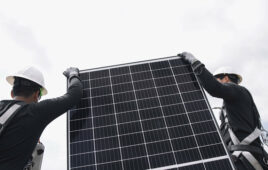
By Ali McBride, Aurora Solar
When you think of solar panel efficiency, you’re most likely thinking about how much sunlight a given panel turns into electricity. While this is certainly an important consideration for customers choosing a new photovoltaic system, it’s far from the only aspect of “efficiency” that goes into a high-performing PV system.
In this blog, we’ll look at a few different variables that go into making an efficient solar installation. We’ll start with how well different panels and panel types turn sunlight into electricity, but also looks at other factors, like planning, installation, and maintenance.
But let’s get started where the rubber hits the road: the panels themselves.





Yes, Solar panel efficiency is measured as a percentage (ranging between 15% to 22%) that determines how much energy a solar panel is able to produce over the course of a year. This is also referred to as solar panel performance.
Certain factors affect solar panel efficiency.
Higher for monocrystalline solar panels
Lower for polycrystalline and thin film solar panels
Measured in watts per meter
Solar panel efficiency ratings are currently between 15% to a maximum of 22%. The higher the efficiency rating, the more energy your panels are going to be able to produce.
Here are some of the factors that affect solar panel efficiency.
The location of your solar panels
The tilt angle of your solar panels
The weather conditions in your area
How well you maintain your solar panels
The build quality of your solar panels
The number of peak daylight hours in your area
It is vital to go for the most efficient panels possible when you decide to go solar.
In just the past 15 years and even with tariffs, solar PV prices have come down to the point where one can actually “over design” their solar PV system to take into account things like dusting of the panels, LID over the useful life of the panel and keeping in mind technologies are coming along that will allow one to have their own EV charging port, to charge one’s EV(s) at home. Folks are taught to use the STC when over the long haul the PTC or NOCT is a better parameter to use when designing a long term solar PV system. Now that manufacturing technology has increased to the point where many panel manufacturers are putting ‘linear’ degradation warranties of 30 years where a panel still puts out from 88% up to 92% of the power when the panel was new. Since there are solar PV panels that were manufactured in the 1970’s that are still in service today and still putting out specified power after 40 years of use makes one believe that solar PV manufactured today could be a 50 plus year legacy product on one’s roof.